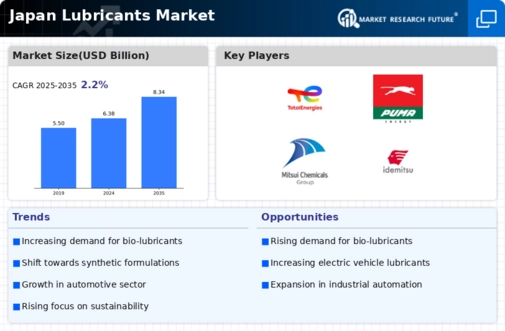The lubricants market in Japan is characterized by a competitive landscape that is both dynamic and multifaceted. Key growth drivers include the increasing demand for high-performance lubricants across various sectors, such as automotive and industrial applications. Major players like Idemitsu Kosan (Japan), JX Nippon Oil & Energy (Japan), and ExxonMobil (US) are strategically positioned to leverage innovation and sustainability initiatives. For instance, Idemitsu Kosan (Japan) focuses on developing eco-friendly lubricants, which aligns with the growing consumer preference for sustainable products. This collective emphasis on innovation and environmental responsibility shapes a competitive environment that is increasingly focused on meeting regulatory standards and consumer expectations.
In terms of business tactics, companies are localizing manufacturing to enhance supply chain efficiency and reduce operational costs. The market structure appears moderately fragmented, with several key players exerting considerable influence. This fragmentation allows for niche players to thrive, while larger corporations optimize their operations through strategic partnerships and technological advancements. The interplay between these tactics and the competitive structure fosters a landscape where agility and responsiveness to market changes are paramount.
In November 2025, JX Nippon Oil & Energy (Japan) announced a strategic partnership with a leading electric vehicle manufacturer to develop specialized lubricants tailored for electric drivetrains. This collaboration is significant as it positions JX Nippon Oil & Energy (Japan) at the forefront of the transition towards electric mobility, potentially capturing a growing segment of the market that demands innovative lubricant solutions. The partnership underscores the importance of aligning product offerings with emerging automotive technologies.
In October 2025, ExxonMobil (US) unveiled a new line of synthetic lubricants designed to enhance fuel efficiency in commercial vehicles. This launch is particularly noteworthy as it reflects ExxonMobil's (US) commitment to addressing the evolving needs of the transportation sector, where fuel efficiency is increasingly critical. By investing in advanced formulations, ExxonMobil (US) aims to strengthen its market position and cater to a customer base that prioritizes performance and sustainability.
In September 2025, Showa Shell Sekiyu (Japan) expanded its product portfolio by introducing a range of biodegradable lubricants. This move is indicative of a broader trend towards sustainability within the lubricants market, as consumers and businesses alike seek environmentally friendly alternatives. Showa Shell Sekiyu's (Japan) proactive approach not only enhances its product offerings but also aligns with global sustainability goals, potentially attracting environmentally conscious consumers.
As of December 2025, current competitive trends in the lubricants market are heavily influenced by digitalization, sustainability, and the integration of artificial intelligence (AI) in product development and supply chain management. Strategic alliances are increasingly shaping the landscape, enabling companies to pool resources and expertise to innovate more effectively. Looking ahead, competitive differentiation is likely to evolve from traditional price-based competition to a focus on innovation, technology, and supply chain reliability. This shift suggests that companies that prioritize R&D and sustainable practices will be better positioned to thrive in an increasingly competitive environment.















Leave a Comment